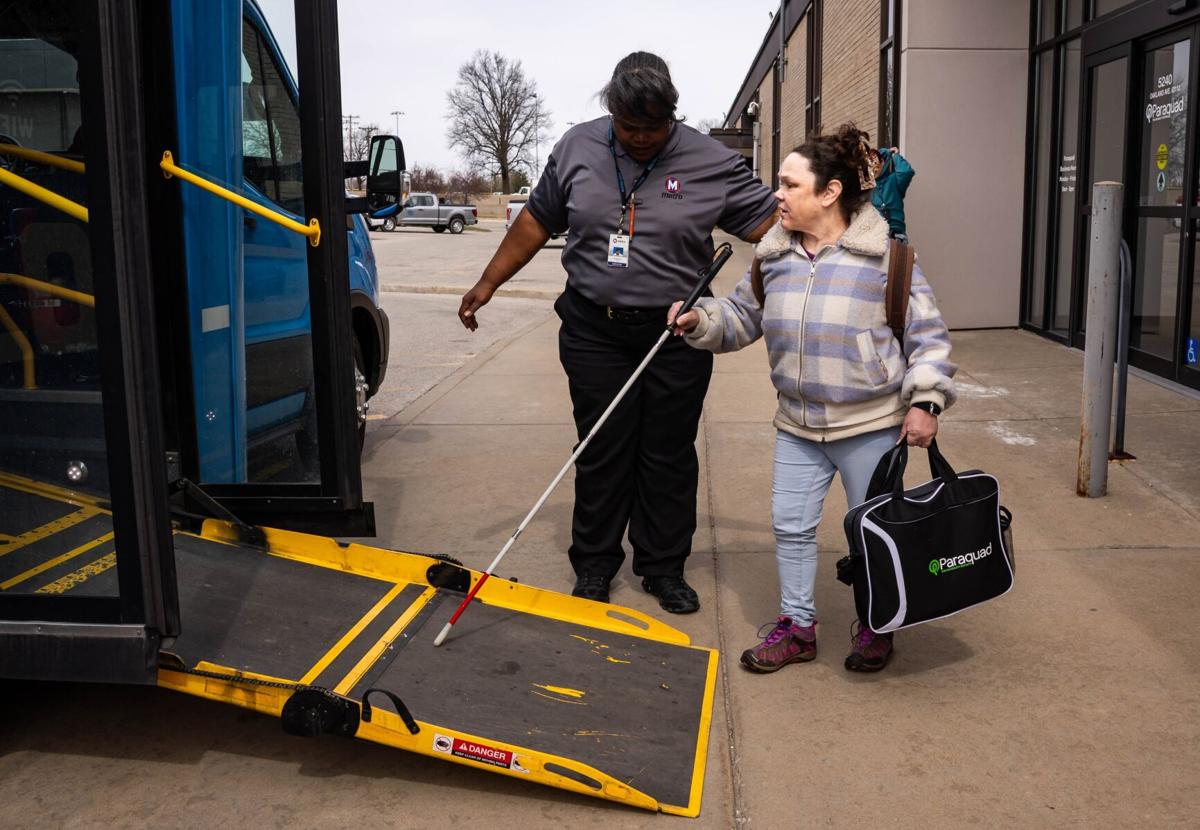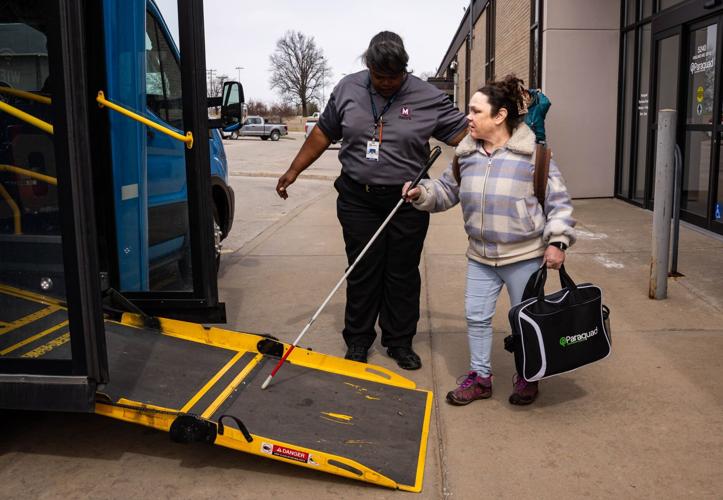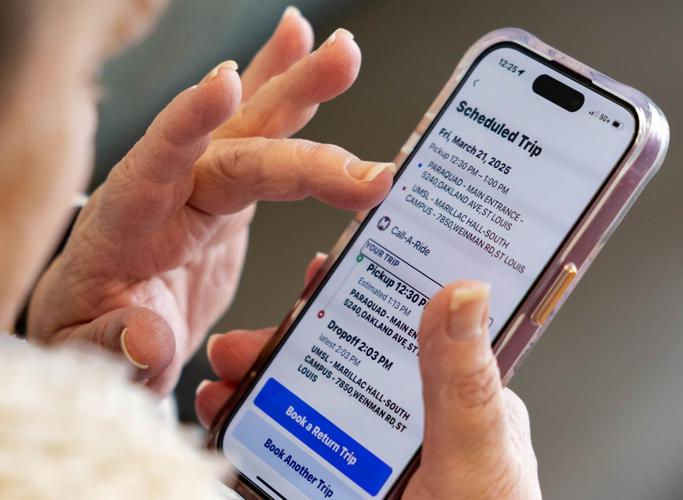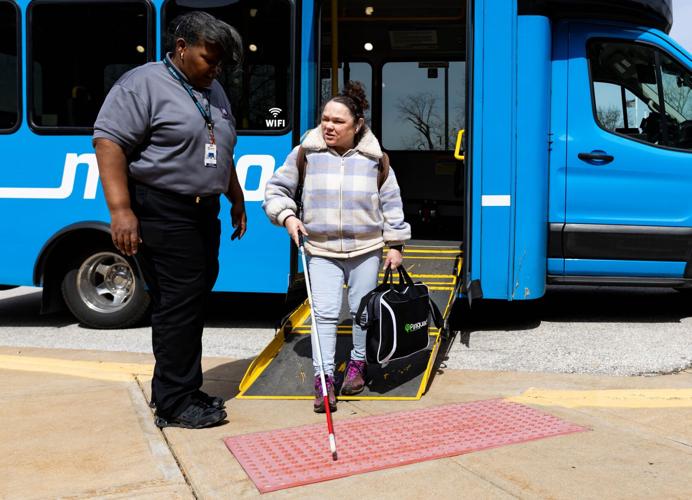
Stephanie McDowell checks the Call-A-Ride app via her phone's screen reader on Friday, March 21, 2025.
ST. LOUIS ÔÇö After months of failing to provide reliable transportation to thousands of people with disabilities, the Ëú╠Ď╩ËĂÁ regionÔÇÖs transit agency has made changes to its door-to-door paratransit service and riders are reporting some success.
Call-A-Ride users no longer wait for hours on the phone to request a ride. Trip denials have decreased to zero. Drivers have new software and tablets to manage trips, and a new mobile phone app allows riders to book and pay for rides.
ÔÇťI donÔÇÖt think weÔÇÖre at a stopping point where we can say, ÔÇśOh, this is the absolute best itÔÇÖs going to get,ÔÇÖÔÇŁ said Stephanie McDowell, a Call-A-Ride user from Maryland Heights. ÔÇťBut at least things are improving.ÔÇŁ
Call-A-Ride, which serves about 9,000 people and provides 40,000 rides a month, still needs work, riders say. McDowell said the service still runs late, and the app has some glitches. Some drivers have complained the new tablets are distracting and that the new software doesnÔÇÖt work efficiently, said drivers union steward William ÔÇťEricÔÇŁ Jones of ATU Local 788.
People are also reading…
ÔÇťItÔÇÖs horrible,ÔÇŁ Jones said.
But Metro Transit touts their improvements.
Chuck Stewart, executive director of Metro, said Call-A-Ride has 180 drivers, up from about 100 a year ago. Last spring, the service was giving about 5,000 rides per week ÔÇö only about half of the number of rides people tried to book. Now, the denial rate is zero with about 8,000 rides per week. Metro also hired a new general manager to oversee Call-A-Ride.
ÔÇťEverybody we talk to in terms of Call-A-Ride services, the first thing they say is, ÔÇśWell, you know, things have gotten a lot better,ÔÇÖ which is great to hear,ÔÇŁ Stewart said.

Stephanie McDowell, youth and family programs manager at disability rights organization Paraquad, exits a Call-A-Ride bus in front of Marillac Hall at the University of Missouri-Ëú╠Ď╩ËĂÁ on Friday, March 21, 2025. McDowell, who is blind, said she uses Call-A-Ride twice most days to get to and from work.
ÔÇśTheyÔÇÖre really tryingÔÇÖ
For much of the past two years, Call-A-Ride was broken, leaving riders with disabilities without a reliable, affordable way to leave their homes, get to work or make it to important doctors appointments.
Labor shortages hit Metro Transit hard during the COVID-19 pandemic, causing the agency to cut back on bus and train schedules as well as Call-A-Ride. A driver shortage prompted Metro to trim Call-A-RideÔÇÖs service area in April 2023, excluding parts of southwest and far north Ëú╠Ď╩ËĂÁ County.
The serviceÔÇÖs reliability tanked. People spent hours on the phone waiting to request transportation days in advance. Sometimes the call would drop, and theyÔÇÖd have to start over. Often, a trip was denied altogether because Metro didnÔÇÖt have enough drivers. And if a rider did manage to secure a reservation, a driver might show up an hour or more behind schedule, causing people to be late for work and appointments. Riders felt stranded, isolated.
Metro faced fierce public backlash for months. Eventually, advocates and riders ended up before the Ëú╠Ď╩ËĂÁ County Council, which controls funding for Metro along with Ëú╠Ď╩ËĂÁ and St. Clair County in the Metro East.
After the County Council held up funding for Metro in October 2023, the agency promised to improve. It hired a consultant to study accessibility and recommend changes. It promised to make Call-A-Ride more reliable and easy to use. But last spring, a group of regional disability rights advocates gave the agency an F on a report card for failing to make enough progress.
A year later, riders say theyÔÇÖre finally seeing improvements, largely because of a new phone app called MetroGo. Metro launched the app in January for about 100 riders who are providing feedback. The agency plans to open it to all users by the end of March.
McDowell, the rider from Maryland Heights, uses Call-A-Ride twice daily to get to and from her job at Paraquad, a disability rights organization in South City. She likes that the app lets her book and track rides, and pay the $4 round-trip fare. McDowell said she experienced multiple trip denials per week before the app, but hasnÔÇÖt been denied a ride since she started using it.
ÔÇťI can see theyÔÇÖre really trying. TheyÔÇÖre really trying to make improvements,ÔÇŁ McDowell said.
But there are still glitches, McDowell said. She finds itÔÇÖs still best to book three days in advance. Drivers still arrive late sometimes, and she might have to call to check on a ride or request a last-minute one. But gone are the days when she waited for hours on the phone to schedule a trip.
Not everyone is convinced. Barbara Sheinbein, who is blind, said she stopped using Call-A-Ride after its reliability sank and a 20-minute drive sometimes took more than an hour. Her friends tell her the service is better, but Sheinbein says sheÔÇÖll continue to rely on ride-share services until sheÔÇÖs certain Call-A-Ride is running efficiently.
ÔÇťI would if I was convinced I wouldnÔÇÖt have hour-and-a-half rides,ÔÇŁ Sheinbein said.

Stephanie McDowell, youth and family programs manager at disability rights organization Paraquad, waits for a Call-A-Ride bus to pick her up at the Paraquad office in Ëú╠Ď╩ËĂÁ on Friday, March 21, 2025. McDowell, who is blind, said she uses Call-A-Ride twice most days to get to and from the office.
Making changes
McDowell waited at Paraquad on Oakland Avenue early Friday afternoon for the Call-A-Ride van to arrive. She was heading to the University of Missouri ÔÇö Ëú╠Ď╩ËĂÁ to help set up for an event the next day, and wanted to be there by 2 p.m.
She had booked a ride on the MetroGo app for between 12:30 and 1 p.m. ÔÇö the service offers half-hour pickup windows. You have to be ready for the van to arrive at any time within that window.
Shortly before 12:30 p.m., the app estimated McDowellÔÇÖs ride would arrive at 1:13 p.m.
Based on that pickup time, the app estimated a 2 p.m. arrival time at UMSL. Just in case, McDowell dictated an email to her contact at the university saying she might be a little late.
The Call-A-Ride van arrived at 1:04 p.m., more than a half an hour after her pickup window started. That happens a lot, McDowell said.
The van dropped McDowell off at UMSL at 1:48 p.m., a few minutes before she had hoped to get there.
ÔÇťI canÔÇÖt say it hasnÔÇÖt gotten better. It has. But I think it can continue to improve,ÔÇŁ McDowell said. ÔÇťThatÔÇÖs what IÔÇÖm hoping for.ÔÇŁ
Jones, the union steward, said Call-A-Ride drivers are having to adjust to changes that are supposed to help them be more efficient, like the new tablets.
Asking them to use the tablets while driving amounts to asking them to break distracted driving laws, he said. And because they canÔÇÖt check notifications while driving, drivers often end up crisscrossing the region to pick up and drop off, frustrating riders, he said.
ÔÇťIt could make a driver whoÔÇÖs been there 30-plus years look incompetent,ÔÇŁ Jones said.
Stewart, the transit director, said the tablets will take some getting used to.
ÔÇťChange is hard. Change takes time,ÔÇŁ Stewart said. ÔÇťJust like the disabled community gave us a shot, gave us a chance, I think our drivers will come around.ÔÇŁ
Seeger Gray of the Post-Dispatch contributed to this report.
Post-Dispatch photographers capture hundreds of images each week; here's a glimpse at the week of March 16, 2025. Video edited by Jenna Jones.












